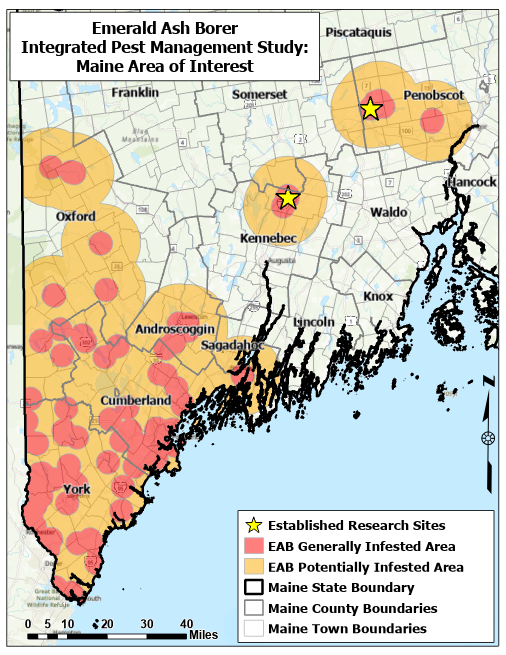Brown Ash Site Wanted for Integrated Pest Management Study on Emerald Ash Borer
The Maine Forest Service and the APCAW Lab at the University of Maine are cooperating with the USDA APHIS Forest Pests Methods Laboratory and private landowners in a study that will integrate insecticide treatments of ash with biological control releases. In this first year of the study, we would like to identify one more cooperating landowner (private or public) with a site suitable for the study and characterize the site in preparation for initial treatments and biological control releases in 2025. In future years, APHIS plans to cooperate with the APCAW Lab at the University of Maine for summer field assistance. Here are some brief details of what is needed in a study site and the planned work:?
Study Duration: Anticipated to be 10 years or more (funding dependent).??
Study site size: At least 10 acres, ideally around 40 acres.?
Study location: Ideally within two hours of either of the currently identified sites (Newport and Waterville, stars on map below), with emerald ash borer (EAB) in the immediate area.?
 |
Description of study trees: More than 150 well distributed ash trees over four (4) inches in diameter at breast height in fair to excellent health, dominant species, brown ash (Fraxinus nigra), but other species of Fraxinus (ash trees) can make up the full 150 study trees. Site should have ash saplings and mature ash and ideally be at least 25 percent ash.?
Accessibility: The site should be easily accessible. During the study, weekly parasitoid releases and trap checks will be necessary.
Harvest expectation: Ideally, there will be no harvest in the treatment area during the duration of the study, but at a minimum, there will be no cutting for at least five years while parasitoids become established.
EAB presence and intensity: EAB detected within one (1) mile of the study site. Parasitoid releases will start within one (1) mile of the ?treatment area.? Less than 10 percent of the ash trees in the ?treatment area? are dead or dying from EAB.
Brief description of study plan:
2024: MFS- Forest Health and Monitoring will identify site. If possible (identified prior to leaf drop), characterize the stand and identify and measure potential treatment trees???????
2025: APCAW lab, APHIS, APHIS-contracted Licensed Commercial Pesticide Applicator; characterize stand, identify, assess, and treat trees in two (2) treatment and ?one (1) control groups, monitor EAB populations using green funnel traps visited on a biweekly basis by project staff, release biological control agents weekly
Treatment group 1: trees treated with injected emamectin benzoate every three years indefinitely
Treatment group 2: trees treated with injected emamectin benzoate every three years until EAB collapses
Control: no treatment
2026: Release biological control agents weekly, assess tree health, monitor EAB population through traps biweekly
2027 and onward: APCAW lab, APHIS, monitor biocontrols through traps and tree peeling, assess tree health, monitor EAB population through traps
Please reach out to us at [email protected] if you think you have a site that would be suitable for this study and are interested in participating.
|
